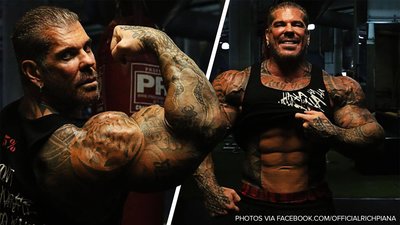There are moments in life of such massive and overwhelming emotional force that you could never forget them if you tried.
When your parents brought home your first dog and it ran through the door into your arms. The moment you first laid eyes on the person who would become your spouse. The birth of your first child.
And, of course, the day you first saw a Rich Piana video.
In the days following Piana's untimely passing at age 46, seemingly every human who has ever set foot in a Planet Fitness and picked up a dumbbell posted a video to give their hot take on what happened and why. But the true importance of Piana—and his loss—can only be ascertained in the weeks and months afterward, as we begin to realize what we're missing.
To be clear, I never met Rich Piana. I reached out to him through industry connections, but was never able to get him to agree to do an interview or allow me to follow him around for a day to profile him. But I'll still miss him, and here's why I think the world of bodybuilding will (and should), too.
The Sleeveless Groom
My introduction to Piana came when I was sprawled out on the floor on the living room floor. I was trying to work out the seemingly permanent knots in my hip flexors on top of a Rumble Roller, while simultaneously tormenting some other knot in a different region of my body with a pair of lacrosse balls stuffed inside an old sock. My wife was sitting at the kitchen table a few feet away doing work on her computer, and I was Chromecasting YouTube videos from my phone.
I finished watching something, and there in the "recommended videos" feed, I saw some guy who looked like an actual monster, covered in tattoos, with a flat brim hat. I'd seen him in my feed before and had gawked at the outsized number of views he'd garnered (in the hundreds of thousands for many of the videos, some in the millions) and had just kept scrolling. I couldn't imagine what could possibly be so entertaining about this guy and whatever it was he was saying or doing.
But on that night, I clicked on a video—Rich Piana's Wedding, now deleted from Piana's channel but living on elsewhere—and it was unlike anything I had ever seen before or have ever seen since. The sight of truly monstrous creatures covered head to toe in tattoos, hoisting Piana high in a throne and carrying him into what looks like the ballroom at a Holiday Inn convention center clad in knee-length tux pants and a tux jacket with the arms cut off was truly…something else.
Now, years later, I still recall a surprising amount of this four-minute video. The obscenities that spewed from his mouth like a nervous, machine gun tick even during a life event as serious as his own wedding. The "King" tattoo he got on his hand immediately before being married. The sheen of the spray tan over muscles so swollen they verged on a physical deformity. The delts that looked like someone had implanted red rubber kickballs next to his collarbones. The veins that looked like baby rattlesnakes slithering around just beneath his paper-thin skin.
There was no reason to watch what I was watching, but I couldn't stop.
I took the red pill, and over an hour later, was still clicking on the next video…and the next. I listened to Piana describe his early life, his success as a high school football player, his rise as a bodybuilder, and, of course, the arsenal of performance-enhancing drugs he took in quantities that suggested he might have cement mixer-sized tanks of the stuff stashed in the McMansions he claimed were part of his burgeoning real estate empire.
It must have been hours later when I got up off the floor and stumbled into bed in a Piana haze, my wife long since having gone to bed without me. I'd gone down the rabbit hole, the same one that millions of fans around the world have gone down. Ever since, he has been lodged squarely in the fitness-focused part of my consciousness.
An Accidental Genius
I've heard Piana called many things before and since his death, but he always struck me as an accidental genius. I saw in him a man who was to bodybuilding what Chris Farley was to comedy: gifted, driven, reckless, totally committed to entertaining, and clearly walking a dangerous line between going far beyond what anyone else would do to entertain his fans and death itself.
He was entertaining, but I didn't (and still don't) understand why. Every part of my rational being tells me I shouldn't be interested in watching an inflated human of truly freakish proportions do things like cut his hair, go to drive-thrus, and talk about his steroid cycles ad infinitum. He had fabricated an entire alternate reality centered around what he called the "5-percent lifestyle," but which is more like the monster truck-body lifestyle.
Piana didn't just have an arms day—he had a 12-hour arms workout. He didn't just put on lean muscle mass—he put on 35 pounds of lean muscle mass in a month, and probably spent more time talking in videos about it than actually lifting weights.
After I watched my first Piana video, I shared the link with my brother and a few friends. None of us have ever been competitive bodybuilders, or would ever want to look like Piana or do any of the things that he did to become the freakish superhero he was. But part of Piana's genius was that he tapped into a small, but dedicated, fan base of truly hardcore bodybuilders, and a huge group of people like us, who have spent time in the weight room, occasionally read muscle mags and websites, and at some point dreamed of looking like Arnold in Terminator or Stallone in the later Rambo films.
Fantasy, drama, and contradiction permeated every aspect of Piana's life. He lived in a world where the highest aspiration was to get as huge and defined as possible, health be damned. He had his own supplement company and meal service, but he also had a gift for shoveling down gallons of ice cream, burgers, and other junk food. His appetites knew no limits, whether it be for cars, food, houses, training volume, or performance-enhancing drugs.
Why Bodybuilding Should Miss Rich Piana
Piana pissed off the entire bodybuilding establishment, but they should thank him. Bodybuilding has long tried to present itself as a healthy lifestyle. But it has a dark side—and not just when it comes to drugs.
I've spent time with some of the world's most elite athletes across sporting disciplines ranging from the UFC and NFL to pro cycling, and all points in between. But the two days I spent with Jay Cutler in the early 2000s, before he won his first Olympia title, defined "athletic discipline" for me moving forward. Yes, all pro athletes have a level of commitment and dedication to their vocations that is beyond the grasp of the amateur dabbler. But the totalizing, 24/7 rigidity that I saw Cutler exhibit blew my mind. His bland, monotonous, totally committed regimen of eating, sleeping, and training was unlike anything I'd ever seen before and was beyond imagination.
It wasn't an exciting lifestyle. And it certainly didn't strike me as healthy. But that's how the industry wants people to see bodybuilding, and the elite competitors are richly rewarded for it.
On the other end of the spectrum, Piana himself told us, over and over, that when it came to the world of competitive, contest bodybuilding, he was a loser. He wasn't a darling of the industry. He wasn't an Olympia champion. But in rejecting that world and becoming the most fully realized version of Rich Piana that he could concoct, he transcended the limitations of the sport and became something different: part caricature, part performance art, part pop-culture icon. In rejecting the bodybuilding status quo, he came to signify "bodybuilding" for mainstream audiences more than only a handful of the all-time greats.
Piana spawned an army of disciples who, much like himself, were covered in tattoos, eschewed competition, and developed physiques of utterly freakish and impressive disproportion. Like a mutant father, he spawned an entirely new evolutionary branch of bodybuilders unlike anything the world had ever seen.
Piana disrupted the muscle industry, gave it the middle finger, and totally eclipsed the sunny "lift right, eat right" narrative we all grew up with. He was a straight shooter to end all straight shooters. I often found myself wondering whether what Piana was talking about was even legal to talk about—couldn't he go to jail for openly discussing his exhaustive drug use? Where did he get this stuff? He was always traveling—how did he take the drugs with him?
Then were the houses and the cars. That all seemed like a facade to me, like a series of rentals and leases set up to bolster Piana's self-proclaimed baller status, as fake as the tattooed-on sideburns and hair that Rich had underneath his dyed black, straightened locks.
Yes, it was phony, but he owned it all. That's where he differed from every other baller, every other bodybuilder, and every other icon. And it was entertaining as hell.
Piana Lives On
My wife will still sometimes wander into the living room and find me on top of my Rumble Roller, looking like I'm humping the floor, as I try to roll out the same old knot and watching the same old Rich Piana videos. Maybe a classic, like the wedding, or some of his newer work I haven't gotten to yet since his cross-country move prior to his death. I don't know why I can't stop watching, but I can't. And neither can you.
In his novel Infinite Jest, David Foster Wallace, another disrupter, imagined a world where there existed a video so entertaining that people who saw it couldn't stop watching it, couldn't do anything else, and died. Piana's videos weren't quite that entertaining, but they were close enough to make me understand the idea.
He died as he lived: sensationally, provocatively, and tragically. People can argue about what killed Piana, how he died, the ethics of what he did and what he spawned. Let them. That's probably how he would have wanted it.

